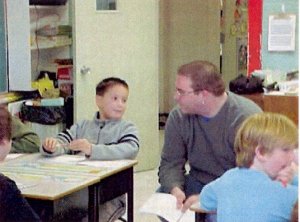
Other researchers and educators are actively designing and implementing classroom strategies to include the boys. Programs include father & son or parent & son book clubs (Good, Calgary Herald, Nov 26, 2003; Murphy, 2001), and single sex classrooms (Wragg, 1997). Others are designing activities which elicit the active and social reading responses preferred by boys (Norman, 2002; Murphy, 2001; Millard, 2001; Leggo, 1998).

The male mentor program was developed in
response to these issues raised in the literature.
Would male readers in an informal, yet in school
program, make a difference in boys' attitudes
toward reading?
What is a Mentor?
In classic literature we learn that Odysseus left his son under the supervision of a friend named Mentor.
Mentor acted as an advisor to the son of Odysseus. Mentoring as a term came into general use as an informal
relationship based on an experienced individual helping a less experienced person. The relationship could be in
a coaching context, or for personal and social development reasons. Mentors may be experts handing down
their knowledge in a variety of fields. Being a role model is also part of the mentoring definition.
Today, father and extended family support is often uncertain. Research continues to examine all indicators including the socio-cultural and economic status of boys' and girls' underachieving in literacy. Large studies like IALS (Kirsch, 1995) and PISA (OECD, 2001) provide rich data revealing many factors along with gender to account for underachievement. Important factors for reading success included family status and the presences of positive role models (often the father). Substituting university men for family members is not perfect but they seemed to be a suitable group to act a mentors and role models. The development of a mentor program for research also relied on studies reporting on the lack of male elementary teachers, the consequently feminized school, and need for "father figures" for "under-fathered boys" (Skelton, 2001, p.137).